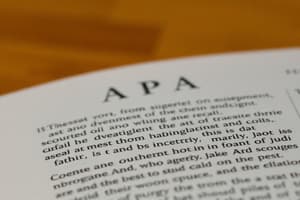Podcast
Questions and Answers
What should be provided when citing a long heading or section name for clarity?
What should be provided when citing a long heading or section name for clarity?
- A full paragraph summary
- An abbreviated heading in quotation marks (correct)
- An irrelevant section name
- Only the author's name
Which citation format is recommended for quoting advice about kidney failure prevention?
Which citation format is recommended for quoting advice about kidney failure prevention?
- Listing items without section references
- Citing the section name with quoted items (correct)
- Using only the publication year
- Citing just the article title
What is an acceptable way to use paragraph numbers in a citation?
What is an acceptable way to use paragraph numbers in a citation?
- Only use numbers after the paragraph is cited
- Ignore paragraph numbers altogether
- Manually count the paragraphs for citation (correct)
- Cite paragraph numbers without context
When combining a section name with a paragraph number in citations, what is one example given?
When combining a section name with a paragraph number in citations, what is one example given?
What is a key reason for moving joints through a full range of motion according to the provided example?
What is a key reason for moving joints through a full range of motion according to the provided example?
In the example provided regarding retirement, what emotional support is suggested to be necessary?
In the example provided regarding retirement, what emotional support is suggested to be necessary?
Why is it vital to use proper citation formats when quoting sources?
Why is it vital to use proper citation formats when quoting sources?
What does the example of quoting rhythmic memory skills illustrate?
What does the example of quoting rhythmic memory skills illustrate?
What is the correct order of elements in a reference for a newspaper article?
What is the correct order of elements in a reference for a newspaper article?
Which citation format is used for in-text citations when referencing an article without an author?
Which citation format is used for in-text citations when referencing an article without an author?
In a reference, which part follows the title of the article?
In a reference, which part follows the title of the article?
What is a necessary component of a reference for a newspaper article?
What is a necessary component of a reference for a newspaper article?
Which of the following represents a correct way to cite a source with an author in-text?
Which of the following represents a correct way to cite a source with an author in-text?
Which part of the reference is italicized?
Which part of the reference is italicized?
What is mentioned as a skill that is disappearing from high schools but is important for college readiness?
What is mentioned as a skill that is disappearing from high schools but is important for college readiness?
What should immediately follow the page number in a reference?
What should immediately follow the page number in a reference?
When referencing a newspaper article, what comes first in the list structure?
When referencing a newspaper article, what comes first in the list structure?
What was the method used in the study by Krashen to relate to vocabulary acquisition?
What was the method used in the study by Krashen to relate to vocabulary acquisition?
What is a requirement for in-text citations according to the guidelines?
What is a requirement for in-text citations according to the guidelines?
Which of the following is NOT a way to format in-text citations?
Which of the following is NOT a way to format in-text citations?
Which element is necessary when directly quoting a source in a research paper?
Which element is necessary when directly quoting a source in a research paper?
What must be ensured about in-text citations and reference lists?
What must be ensured about in-text citations and reference lists?
Which statement is true about personal communications in citations?
Which statement is true about personal communications in citations?
What is a potential limitation of Krashen's claim regarding vocabulary acquisition?
What is a potential limitation of Krashen's claim regarding vocabulary acquisition?
What punctuation is used to separate multiple authors in a journal reference?
What punctuation is used to separate multiple authors in a journal reference?
In the reference list for an article without an author, what should be included in place of the author name?
In the reference list for an article without an author, what should be included in place of the author name?
Which format is correct for referencing an online journal article with a DOI?
Which format is correct for referencing an online journal article with a DOI?
What should replace the 'doi' in a journal reference if the article is accessed online without a DOI?
What should replace the 'doi' in a journal reference if the article is accessed online without a DOI?
When citing a news article in-text, which of the following formats is correct?
When citing a news article in-text, which of the following formats is correct?
How should the title of a journal be formatted in a reference list?
How should the title of a journal be formatted in a reference list?
In an article reference for a print newspaper, which element is included after the newspaper title?
In an article reference for a print newspaper, which element is included after the newspaper title?
What is the primary purpose of indicating similarities between sources in a literature review?
What is the primary purpose of indicating similarities between sources in a literature review?
Which of the following best describes the process of contrast in literature reviews?
Which of the following best describes the process of contrast in literature reviews?
Why is critical analysis particularly important for university students and professors?
Why is critical analysis particularly important for university students and professors?
In the context of contrasting research, what does Wankey (2023) emphasize regarding research design?
In the context of contrasting research, what does Wankey (2023) emphasize regarding research design?
What is a common outcome of poor critical analysis in literature reviews?
What is a common outcome of poor critical analysis in literature reviews?
What is indicated by presenting the RRL in qualitative research according to multiple authors?
What is indicated by presenting the RRL in qualitative research according to multiple authors?
What does the term 'common denominator' refer to in the context of contrasting sources?
What does the term 'common denominator' refer to in the context of contrasting sources?
Which of the following is a sign of good reading skills in literature reviews?
Which of the following is a sign of good reading skills in literature reviews?
What should you do when citing works that share the same authors except for one?
What should you do when citing works that share the same authors except for one?
What is the correct abbreviation for the World Health Organization in citations?
What is the correct abbreviation for the World Health Organization in citations?
Which of the following statements is true regarding the citation method for group authors?
Which of the following statements is true regarding the citation method for group authors?
What does 'et al.' mean in citations?
What does 'et al.' mean in citations?
When citing a secondary source, what should you primarily do?
When citing a secondary source, what should you primarily do?
Which citation format is correct for the first citation of the Ministry of Health?
Which citation format is correct for the first citation of the Ministry of Health?
How should subsequent citations of a group author be formatted after the first citation?
How should subsequent citations of a group author be formatted after the first citation?
When multiple authors are present in a citation, what should be done if the final author's name differs between two works?
When multiple authors are present in a citation, what should be done if the final author's name differs between two works?
Flashcards
Comparison in Literature Review
Comparison in Literature Review
Highlighting similarities between different sources in a literature review.
Contrast in Literature Review
Contrast in Literature Review
Pointing out differences between two or more sources in a literature review.
Critical Analysis
Critical Analysis
Evaluating the strength and weaknesses of research findings through examination of arguments and evidence.
Purpose of Comparison
Purpose of Comparison
Signup and view all the flashcards
Purpose of Contrast
Purpose of Contrast
Signup and view all the flashcards
Critical Analysis in Research
Critical Analysis in Research
Signup and view all the flashcards
Role of Critical Analysis
Role of Critical Analysis
Signup and view all the flashcards
Level of Critical Analysis
Level of Critical Analysis
Signup and view all the flashcards
In-text Citation
In-text Citation
Signup and view all the flashcards
Parenthetical Citation
Parenthetical Citation
Signup and view all the flashcards
Direct Quote
Direct Quote
Signup and view all the flashcards
APA Style Citation
APA Style Citation
Signup and view all the flashcards
Reference List
Reference List
Signup and view all the flashcards
In-text Citation Rules
In-text Citation Rules
Signup and view all the flashcards
Why use citations?
Why use citations?
Signup and view all the flashcards
Personal Communication
Personal Communication
Signup and view all the flashcards
Shortening Author Lists
Shortening Author Lists
Signup and view all the flashcards
Avoiding Ambiguity
Avoiding Ambiguity
Signup and view all the flashcards
Single-Name Difference
Single-Name Difference
Signup and view all the flashcards
Group Authors
Group Authors
Signup and view all the flashcards
Recognized Abbreviations
Recognized Abbreviations
Signup and view all the flashcards
Secondary Sources
Secondary Sources
Signup and view all the flashcards
Original Material
Original Material
Signup and view all the flashcards
Applying Rules to Groups
Applying Rules to Groups
Signup and view all the flashcards
Journal Article Reference (with DOI)
Journal Article Reference (with DOI)
Signup and view all the flashcards
Journal Article Reference (with URL)
Journal Article Reference (with URL)
Signup and view all the flashcards
In-text Citation (Journal Article)
In-text Citation (Journal Article)
Signup and view all the flashcards
Journal Article Reference (no author)
Journal Article Reference (no author)
Signup and view all the flashcards
News Article Reference (print)
News Article Reference (print)
Signup and view all the flashcards
News Article Reference (on-line)
News Article Reference (on-line)
Signup and view all the flashcards
What is the purpose of in-text citations?
What is the purpose of in-text citations?
Signup and view all the flashcards
What are the main elements of a journal article reference?
What are the main elements of a journal article reference?
Signup and view all the flashcards
Reference Structure
Reference Structure
Signup and view all the flashcards
Why is referencing important?
Why is referencing important?
Signup and view all the flashcards
What are the four elements of a reference?
What are the four elements of a reference?
Signup and view all the flashcards
What are the components of an in-text citation?
What are the components of an in-text citation?
Signup and view all the flashcards
Why is it important to use the correct reference style?
Why is it important to use the correct reference style?
Signup and view all the flashcards
What are the advantages of using a referencing tool?
What are the advantages of using a referencing tool?
Signup and view all the flashcards
Study Notes
Course Information
- Course: Criminological Research 1
- Semester/Academic Year: First Semester/2023-2024
- Module Number: 2
- Lesson Title: APA Style Referencing
Learning Outcomes
- Students will discuss the rules/guidelines in referencing different sources (in-text and reference list).
- Students will properly cite resources using the APA style (7th Edition).
- Students will apply the rules of guidelines in referencing source that includes in-text and reference list.
- Students will apply the proper citation of references.
Student Learning Strategies
- Synchronous Online Learning (Zoom): Three-hour class discussion, access to online discussion link beforehand, online/onsite assessment tasks, performance tasks assessed using provided rubrics, and reference to Facebook group for instructions.
- Asynchronous Online Learning (Google Classroom): Recorded video lectures, PowerPoint presentations, self-paced learning modules and other course materials uploaded to Google Classroom, and assessment tasks given during online/onsite discussions.
APA Style Referencing
- Referencing is important in academic writing, both morally (acknowledging other's work) and legally (avoiding plagiarism).
- Referencing appears in the body of research text and the bibliography.
- In-text Citation: Used in the body of the research paper when using other's work to support or argue ideas.
- Reference List: Alphabetical list (on a separate page) of all cited sources.
In-Text Citations Techniques
- Direct Quote: Use quotation marks. No more than three direct quotes per page; each quote should ideally be no longer than twenty words.
- Paraphrasing: Summarizing ideas in your own words, preferred in research writing.
- Comparison: Showing similarities between different sources.
- Contrast: Highlighting differences between different sources.
- Critical Analysis: Providing your critical assessment of the source's claims, usually expected from teachers, university students, and professors.
- Author and Year: Include the authors' last name and the year of publication when citing sources. If there is more than one author, use the "et al." abbreviation for subsequent citations when the information is repeated in the text.
- Page Numbers: Include page numbers when directly quoting a source.
- In-text citations: Provide the surname of the author(s) or the name(s) of the group author(s) and year.
- One Author Examples: Water is a necessary part of everyone's diet (Whitney, 2011).
- Two Author Examples: Whitney and Rolfes (2011) emphasize that water is vital to body function.
- Multiple Authors/Anonymous/Groups: Adapt approach based on if the content has an author/editor, one author, or more than one author etc.
- Secondary Sources: Cite the original source "as cited in" another source in the text, and list the secondary source in the reference list.
Citing Internet Sources
- General Format: Author (Last Name, Initial(s)), date, title of article (in italics), website/URL
- Blog Posts: Apply the same style used for citing books or journals about the author and date format
- YouTube/Video Clips: Use the name of the uploader, channel name, the date of the video upload, include the video title (italicized/in quotation marks, with the word "Video"), the website, and the video link.
- No Author/Date: If there is no author or a date given, italicize the title and then put the date in brackets,
- Corporate Author/Government Agency: The organization is listed as the author, using their name in full for first citation, using an abbreviation (in brackets) in subsequent citations.
Sources With No Year of Publication
- Use "n.d." (no date) in place of publication year.
Quotations from Research Participants
- Direct quotations treated differently than quotes from published works
- Use the same formatting as other quotations (short quote, block quote).
- Cite the participant as the source (ex: Participant A says X, Participant B says Y).
Web Content in-Text Citations
- The author-date format is still used
- Include the URL.
Four Elements of a Reference
- Author
- Date
- Title
- Source
Reference List Rules
- Alphabetical order by author's last name.
- Multiple works by the same author ordered by date (oldest first).
- If no author, alphabetize by the first significant word, excluding articles "a," "an," and "the".
- Use "&" instead of "and" when listing multiple authors.
- First line left-justified, subsequent lines indented.
- Capitalize only the first word of title or subtitle, and any proper names.
- Italicize the title of the book, journal, or web document.
Additional Information
- The notes include examples of various citation formats and are also applicable to online content and resources.
Studying That Suits You
Use AI to generate personalized quizzes and flashcards to suit your learning preferences.




